JavaScript is disabled for your browser. Some features of this site may not work without it.
Buscar en RiuNet
Listar
Mi cuenta
Estadísticas
Ayuda RiuNet
Admin. UPV
Novel Tissue-Engineered Multimodular Hyaluronic Acid-Polylactic Acid Conduits for the Regeneration of Sciatic Nerve Defect
Mostrar el registro sencillo del ítem
Ficheros en el ítem
| dc.contributor.author | Gisbert Roca, Fernando
|
es_ES |
| dc.contributor.author | Gil Santos, Luis
|
es_ES |
| dc.contributor.author | Mata Roig, Manuel
|
es_ES |
| dc.contributor.author | Milian Medina, Lara
|
es_ES |
| dc.contributor.author | Martínez-Ramos, Cristina
|
es_ES |
| dc.contributor.author | Monleón Pradas, Manuel
|
es_ES |
| dc.date.accessioned | 2023-04-21T18:01:32Z | |
| dc.date.available | 2023-04-21T18:01:32Z | |
| dc.date.issued | 2022-05 | es_ES |
| dc.identifier.uri | http://hdl.handle.net/10251/192910 | |
| dc.description.abstract | [EN] The gold standard for the treatment of peripheral nerve injuries, the autograft, presents several drawbacks, and engineered constructs are currently suitable only for short gaps or small diameter nerves. Here, we study a novel tissue-engineered multimodular nerve guidance conduit for the treatment of large nerve damages based in a polylactic acid (PLA) microfibrillar structure inserted inside several co-linear hyaluronic acid (HA) conduits. The highly aligned PLA microfibers provide a topographical cue that guides axonal growth, and the HA conduits play the role of an epineurium and retain the pre-seeded auxiliary cells. The multimodular design increases the flexibility of the device. Its performance for the regeneration of a critical-size (15 mm) rabbit sciatic nerve defect was studied and, after six months, very good nerve regeneration was observed. The multimodular approach contributed to a better vascularization through the micrometrical gaps between HA conduits, and the pre-seeded Schwann cells increased axonal growth. Six months after surgery, a cross-sectional available area occupied by myelinated nerve fibers above 65% at the central and distal portions was obtained when the multimodular device with pre-seeded Schwann cells was employed. The results validate the multi-module approach for the regeneration of large nerve defects and open new possibilities for surgical solutions in this field. | es_ES |
| dc.description.sponsorship | This research was funded by the Spanish Government's State Research Agency (AEI) through projects DPI2015-72863-EXP and RTI2018-095872-B-C22/ERDF. Funding for open access charge: Universitat Politecnica de Valencia. | es_ES |
| dc.language | Inglés | es_ES |
| dc.publisher | MDPI AG | es_ES |
| dc.relation.ispartof | Biomedicines | es_ES |
| dc.rights | Reconocimiento (by) | es_ES |
| dc.subject | Nerve guidance conduit | es_ES |
| dc.subject | Hyaluronic acid | es_ES |
| dc.subject | Polylactic acid | es_ES |
| dc.subject | Aligned substrates | es_ES |
| dc.subject | Schwann cells | es_ES |
| dc.subject | Nerve regeneration | es_ES |
| dc.subject.classification | MAQUINAS Y MOTORES TERMICOS | es_ES |
| dc.title | Novel Tissue-Engineered Multimodular Hyaluronic Acid-Polylactic Acid Conduits for the Regeneration of Sciatic Nerve Defect | es_ES |
| dc.type | Artículo | es_ES |
| dc.identifier.doi | 10.3390/biomedicines10050963 | es_ES |
| dc.relation.projectID | info:eu-repo/grantAgreement/AEI/Plan Estatal de Investigación Científica y Técnica y de Innovación 2017-2020/RTI2018-095872-B-C22/ES/NUEVO DISPOSITIVO BIOACTIVO PARA LA REGENERACION DE LESIONES DE LA MEDULA ESPINAL/ | es_ES |
| dc.relation.projectID | info:eu-repo/grantAgreement/MECD//FPU16%2F01833/ES/FPU16%2F01833/ | es_ES |
| dc.relation.projectID | info:eu-repo/grantAgreement/MINECO//DPI2015-72863-EXP/ES/NEUROCABLES MODULARES: MULTIPLICANDO CONEXIONES NEURALES/ | es_ES |
| dc.rights.accessRights | Abierto | es_ES |
| dc.contributor.affiliation | Universitat Politècnica de València. Escuela Técnica Superior de Ingenieros Industriales - Escola Tècnica Superior d'Enginyers Industrials | es_ES |
| dc.description.bibliographicCitation | Gisbert Roca, F.; Gil Santos, L.; Mata Roig, M.; Milian Medina, L.; Martínez-Ramos, C.; Monleón Pradas, M. (2022). Novel Tissue-Engineered Multimodular Hyaluronic Acid-Polylactic Acid Conduits for the Regeneration of Sciatic Nerve Defect. Biomedicines. 10(5):1-22. https://doi.org/10.3390/biomedicines10050963 | es_ES |
| dc.description.accrualMethod | S | es_ES |
| dc.relation.publisherversion | https://doi.org/10.3390/biomedicines10050963 | es_ES |
| dc.description.upvformatpinicio | 1 | es_ES |
| dc.description.upvformatpfin | 22 | es_ES |
| dc.type.version | info:eu-repo/semantics/publishedVersion | es_ES |
| dc.description.volume | 10 | es_ES |
| dc.description.issue | 5 | es_ES |
| dc.identifier.eissn | 2227-9059 | es_ES |
| dc.identifier.pmid | 35625700 | es_ES |
| dc.identifier.pmcid | PMC9138968 | es_ES |
| dc.relation.pasarela | S\462065 | es_ES |
| dc.contributor.funder | MINISTERIO DE EDUCACION | es_ES |
| dc.contributor.funder | AGENCIA ESTATAL DE INVESTIGACION | es_ES |
| dc.contributor.funder | Universitat Politècnica de València | es_ES |
| upv.costeAPC | 2396 | es_ES |








